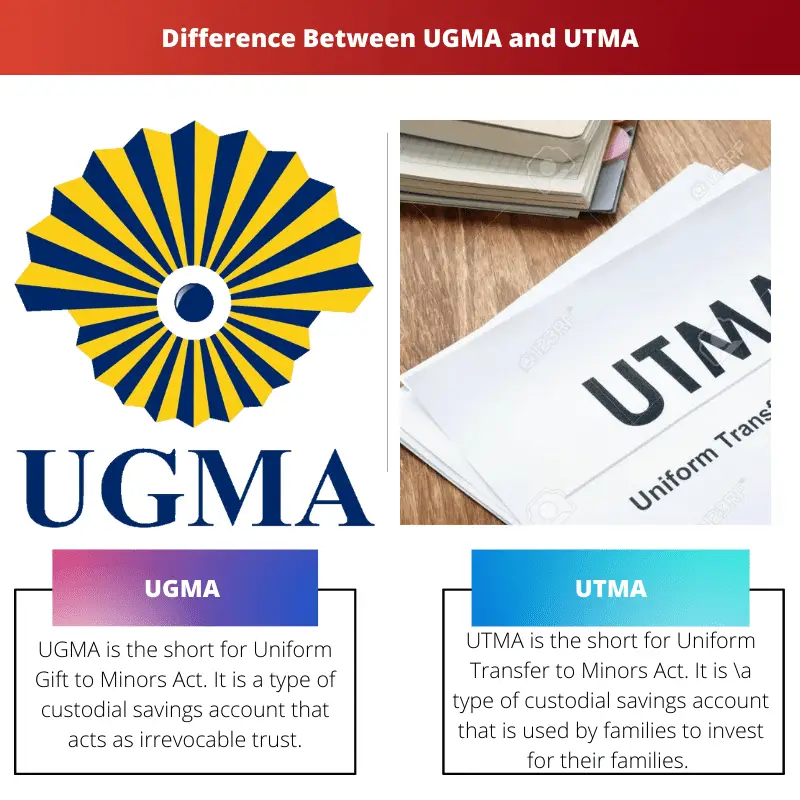UGMA (Uniform Gift to Minors Act) and UTMA (Uniform Transfers to Minors Act) are both laws that allow adults to transfer assets to minors without the need for a formal trust. However, UTMA allows for a broader range of assets, including real estate and intellectual property, compared to UGMA, which primarily covers securities and cash. Additionally, UTMA extends the age of termination, providing greater flexibility for the custodian to manage the assets for the minor’s benefit.
Key Takeaways
- UGMA stands for Uniform Gifts to Minors Act, while UTMA stands for Uniform Transfers to Minors Act.
- UGMA allows for gifting money or assets to minors in a custodial account. In contrast, UTMA allows for gifting a wider range of assets, including real estate, intellectual property, and fine art.
- UGMA custodial accounts must be liquidated and transferred to the minor at age 18, while UTMA custodial accounts can be held until age 25 in some states.
UGMA vs. UTMA
UGMA allows adults to make irrevocable gifts of cash, securities, and other assets to minors without a formal trust, with the custodian managing the assets until the minor reaches majority. The UTMA allows adults to make irrevocable gifts of cash, securities, and other assets to minors, with an age of majority of 18 or 21.

UGMA is the abbreviated form of the Uniform Gift to Minors Act. It is a custodial savings account that allows a family to donate basic assets for their children’s future, which are handed over to beneficiaries when they complete the age of 18.
UTMA is also a savings account but allows a broader range of assets to be donated, and it matures when beneficiaries reach 25 years of age.
Comparison Table
| Feature | UGMA (Uniform Gifts to Minors Act) | UTMA (Uniform Transfers to Minors Act) |
|---|---|---|
| Allowed Assets | Financial instruments only (cash, stocks, bonds, mutual funds) | Wider range: financial instruments, tangible personal property (e.g., jewelry, artwork), and real estate |
| State Availability | Available in all states | Not available in South Carolina and Vermont |
| Custodian Control | Ends when the child reaches the age of majority (18, 19, or 21 depending on state) | Ends when the child reaches the age of majority (up to 25 depending on state law) |
| Tax Treatment | Earnings taxed at the child’s tax rate (potentially subject to the “Kiddie Tax”) | Earnings taxed at the child’s tax rate (potentially subject to the “Kiddie Tax”) |
| Financial Aid Impact | Reported as a child asset on the FAFSA, reducing aid eligibility by 20% of the asset value | Reported as a child asset on the FAFSA, reducing aid eligibility by 20% of the asset value |
| Investment Options | Wider range: can be tailored to the child’s age and risk tolerance | Limited: age-based or target-date funds |
| Uses of Funds | Any purpose, not just education | Any purpose, not just education |
What is the Uniform Gift to Minors Act?
The Uniform Gift to Minors Act (UGMA) is a legal framework established in the United States to facilitate the transfer of assets to minors without the need for a formal trust. It provides a straightforward mechanism for adults, parents or grandparents, to transfer assets to minors, with a designated custodian managing the assets until the minor reaches the age of majority.
Key Features of UGMA
- Transfer of Assets: Under UGMA, adults can transfer a variety of assets to minors, including cash, securities, and other financial instruments. These assets are irrevocable gifts, meaning the donor relinquishes control over them once the transfer is made.
- Custodianship: Upon transfer, the assets are held in a custodial account for the benefit of the minor. The custodian, who is a parent or another adult, manages the assets and makes decisions regarding their investment and use until the minor reaches the age of majority specified by state law.
- Tax Implications: Income generated by the assets in a UGMA account is taxed at the minor’s tax rate. However, there are certain exceptions and considerations regarding tax implications, and it’s advisable to consult a tax professional for personalized advice.
- Age of Majority: The age at which the minor gains control over the assets varies by state and may range from 18 to 21 years old. Upon reaching the age of majority, the minor gains full control over the assets, and the custodianship terminates. The minor can then use the assets as they see fit, whether for educational expenses, investments, or other purposes.

What is the Uniform Transfer to Minors Act?
The Uniform Transfers to Minors Act (UTMA) is a legal framework in the United States that allows adults to transfer assets to minors in a manner similar to the Uniform Gift to Minors Act (UGMA). UTMA offers greater flexibility and a broader scope of assets compared to UGMA, enabling the transfer of various types of property to minors while providing a designated custodian to manage these assets until the minor reaches the age of majority.
Key Features of UTMA
- Expanded Scope of Assets: UTMA allows for the transfer of a wider range of assets compared to UGMA. In addition to cash, securities, and financial instruments, UTMA permits the transfer of real estate, tangible personal property, intellectual property rights, and other types of assets.
- Custodial Management: Similar to UGMA, UTMA establishes a custodial arrangement where an adult, a parent or guardian, manages the assets on behalf of the minor beneficiary. The custodian has the authority to invest, manage, and use the assets for the minor’s benefit until they reach the age of majority specified by state law.
- Tax Considerations: Income generated by the assets held in a UTMA account is taxed at the minor’s tax rate. However, tax implications may vary depending on the nature of the assets and the specific provisions of tax law. It’s advisable to seek guidance from tax professionals to understand the tax consequences of UTMA transfers and account management.
- Extended Age of Termination: UTMA extends the age of termination beyond that of UGMA, allowing the custodian to manage the assets for the minor’s benefit for a longer period. While the age of majority still varies by state, UTMA may specify an older age for termination, such as 21 years old or even older in some jurisdictions.

Main Differences Between UGMA and UTMA
- Asset Types:
- UGMA primarily allows for the transfer of cash, securities, and financial instruments.
- UTMA permits a broader range of assets, including cash, securities, real estate, tangible personal property, intellectual property rights, and other types of assets.
- Age of Termination:
- The age of termination for UGMA accounts varies by state but ranges from 18 to 21 years old.
- UTMA specifies an older age for termination, such as 21 years old or even older in some jurisdictions, allowing for a longer period of custodial management.
- Flexibility:
- UTMA offers greater flexibility compared to UGMA due to its broader scope of assets and extended age of termination.
- UGMA provides a more limited framework, primarily focusing on cash, securities, and a younger age of termination.
- Tax Implications:
- Both UGMA and UTMA subject income generated by the assets to taxation at the minor’s tax rate.
- Tax implications may vary depending on the nature of the assets and specific provisions of tax law, so seeking guidance from tax professionals is advisable for both UGMA and UTMA accounts.
- Uniformity:
- Both UGMA and UTMA are based on uniform acts adopted by most states, providing consistency in legal framework and implementation across jurisdictions.
- While there are differences between UGMA and UTMA, both serve as effective means for adults to transfer assets to minors without the need for a formal trust.




